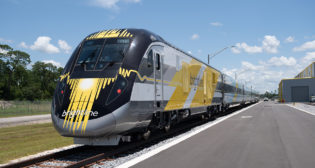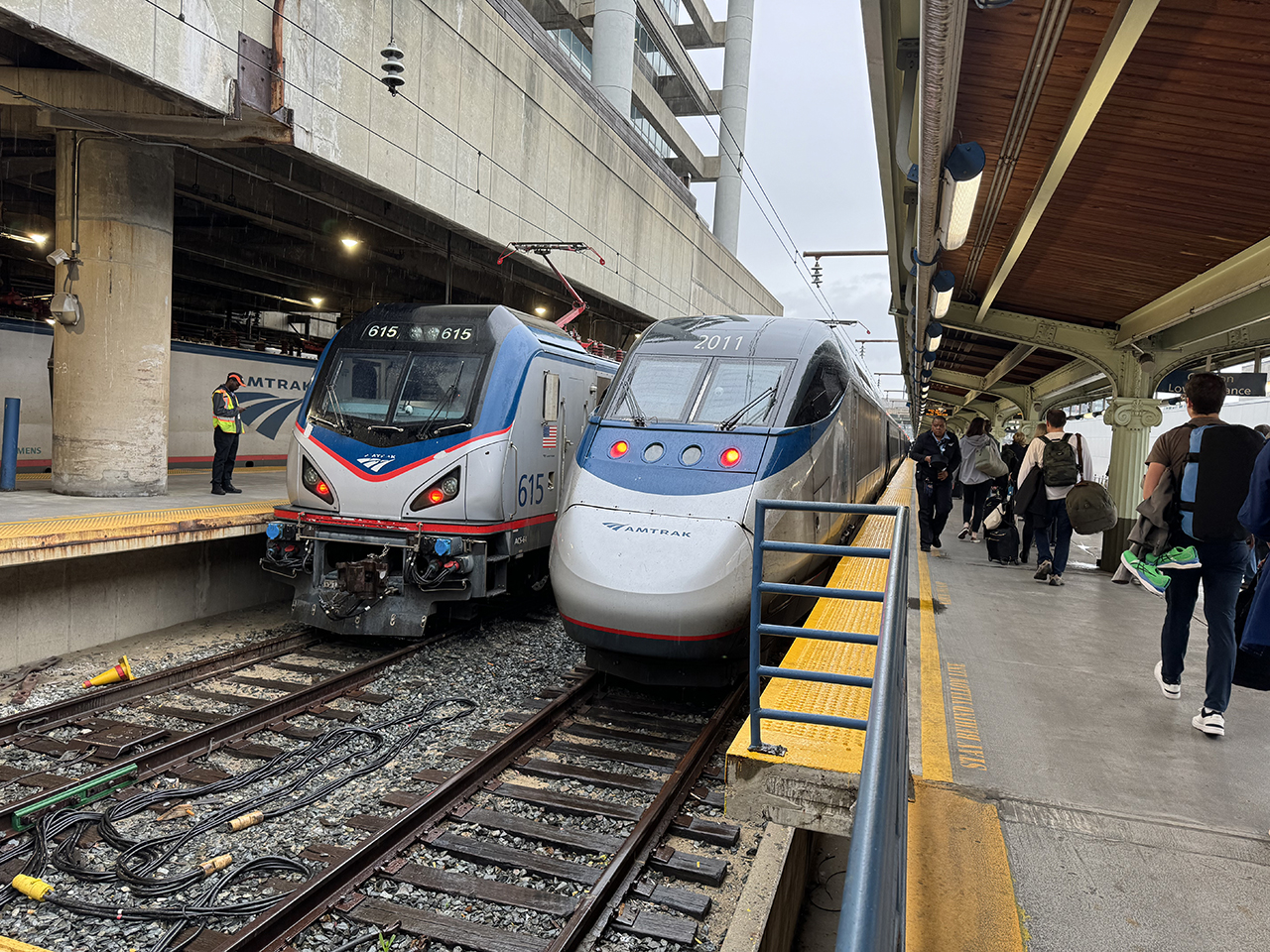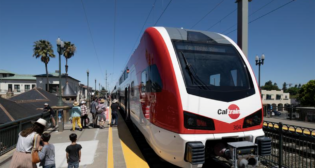
Vehicle/Track Interaction: ‘Science’ or ‘Gibberish’?
Written by Alfred E. Fazio, Alfred E. Fazio, P.E., Contributing Editor
An Amfleet-hauling Siemens ACS-64 electric is pictured next its much older ”cousin,” an Acela trainset, at Washington D.C. Union Station, April 2024. William C. Vantuono photo.
One of our society’s current mantras is to “Follow the Science.” Unfortunately, this oft-repeated phrase cannot distinguish between science and myth, so one may not always be perfectly clear about the causes, manifestations and effects of global climate change, or of the value of annual repeats of COVID vaccines.
Some may face this quandary with respect to FRA’s standards and requirements for high-speed rail (HSR), in particular, the 49 CFR 213 Part G requirements for Vehicle/Track Interaction (VTI). Is Part G “Science,” or is it “Gibberish”? These standards apply to operation at speeds greater than 90 mph. Consequently, they potentially apply to the next increment in high-performance regional/commuter rail operations as well as what is typically thought of as HSR.
This question takes on new importance with the real likelihood of expansion in high-speed passenger service beyond Amtrak’s current Acela and Northeast Regional operations, California High-Speed Rail and Brightline West for example. More immediate, it is important to consider that Part G applies to any speed above 90 mph. Thus, the Amtrak Harrisburg Line and Empire Line require consideration, as do other operations, such as portions of Metra (Chicago) and lines in California that may desire to achieve speeds greater than 90 mph.
In considering the Gibberish vs. Science quandary, two concepts that were paramount in the formulation of Part G standards are of great relevance:
- The importance of a systems approach to formulation of track standards; that is, a recognition of the importance of specialized-design HSR equipment in formulating standards for the track over which equipment was to operate.
- Given that a robust track structure exists and recognizing that track geometry serves as a “forcing function” on the vehicle, track geometry standards should be “performance-based,” i.e., based on the railcar’s dynamic responses (amplitudes, forces, displacement of various carbody components) to track geometry.
Another important consideration in the formulation of Part G is that above a certain speed, reductions in the amplitude of geometry defects (mid-chord offsets) to fixed wavelength measurements (for example, a 62-foot chord, as occurs with geometry in lower track classes) are not of utmost importance. Rather, high speeds require extension of measurement distance and control of geometric defects over longer wavelengths.
An early research report noted (Analytical Description of Dynamically Severe Track Geometry Variations, Hamid, A; Owings, R; Kenworthy, M, October 1979, USDOT [FRA]) that the new high-speed standards required long-chord length measurements. With this understanding, the next element in the development of track standards for HSR evaluated which of the many available geometry parameters were of interest. These geometry descriptors were selected based upon their ability to be directly traced to a specific cause of derailment. Here, the introduction of Engineering Mechanics Modeling that was complimented by professional maintenance-of-way experience (science as a compliment to empiricism) was of benefit in selecting performance-based geometry anomalies/descriptors. A variety of derailment scenarios were considered, e.g., wheel lift (L/V ratio), wheel climb (Nadal’s Limit), track panel shift. This investigation began in earnest in 1996-1997 with the RSAC Technical Working Group and has continued (Track and Vehicle Track Interaction, Safety Assurance for US High Speed Rail, report prepared by the RSAC Technical Working Group, July 1997).
Part G Requirements

The current version of Part G has evolved over roughly 35 years and is the product of professional (hands-on) experience, research that included evaluations of European and Japanese high-speed practices, and comprehensive engineering analysis. One might suggest that the developmental processes date to the 100-mph derailment of a GE E60CP electric locomotive at Elkton, Md. on the Northeast Corridor during testing in 1975 (“The Fabulous GG1 vs. the E-60CP,” Bert Pennypacker, Rails Northeast, September 1976). 49 CFR 213 Part G specifies several regulatory and procedural requirements that are admittedly complex and require a significant effort to accomplish. Some who would eliminate or disregard certain of these requirements, or others who consider them unduly burdensome, may not understand their genesis or intent.

Approval for operation at speeds greater than 90 mph (Class 6 at 110 mph; Class 7 at 125; Class 8 at 160 mph; or Class 9, above 160 mph) is only afforded on a route-specific and vehicle-specific basis. Qualification on both items is necessary. In effect, there is really no such thing as Class 7 track; it is only Class 7 for a specific trainset.
The qualification process for operation of a new high-speed train on a new route may be summarized as:
- A vehicle-specific analytical model must be developed, one that adequately represents the train’s response to track (geometry) forcing functions. A generic model vehicle model is not acceptable.
- The response (in terms of forces, displacements, accelerations) of the vehicle (model) to a series of standardized and representative track geometry inputs, referred to as Minimally Compliant Analytical Track or MCAT, is determined (49 CFR 213, PART G, see Appendix D for further MCAT information).
- The proposed route is tested for compliance with track standards for the specific Class representing the desired maximum speed. The recorded geometry is also used as an input to vehicle modeling.
- The vehicle is subject to comprehensive field testing.
- An instrumented train comprised of the train attempting qualification is operated at speed over the route proposed for high-speed service.
Why All This?
The analytical modelling is extremely important for several reasons. Prior to the issuance of Part G, Amtrak was permitted to operate Metroliners (AEM-7 hauled Amfleet consists) at 125 mph (above the Class 6 limit of 110 mph) under the so-called Class 6X Waiver. One of the Waiver requirements was that Amtrak’s Amfleet-based Geometry Car test all high-speed tracks monthly. Further, the Geometry Car was equipped with floor-mounted accelerometers to measure horizontal and vertical accelerations of greater than 0.30g and 0.35g, respectively.
In many instances, a geometry “hit” occurred in the absence of an acceleration exceedence; the converse often occurred as well. In the case of the latter, a speed restriction was immediately imposed pending “on the ground” inspection by a qualified track inspector. Unfortunately, sending a track inspector to find an “acceleration” defect, particularly one that may have been caused by long (or, even more of a search and inspect challenge, combinations of long) wavelength anomalies was analogous to the Navy’s tradition of sending a seaman recruit assigned to his first ship to “fetch a pail of steam.” The analytical model would at least approximate the cause-and-effect relationship between geometry anomalies (particularly combinations) and accelerations for that specific railcar.
The modeling for the initial Part G Standards in 1997 was accomplished prior to the deployment of the Acela trainsets. As such, the vehicle model was a good but not fully accurate representation of the trainset. The reasons for a model specific to and accurately representing all the typical conditions of critical vehicle (lumped mass, wheel contour, spring performance, damping coefficients) are evidenced by an incident that occurred in 2014 during testing for the New Jersey High Speed Rail (NJHSR) Program in 2014. The intent of this program, which was funded by the FRA at roughly $450 million, was to raise the MAS (maximum allowable speed) for Acelas from 150 mph (an 18-mile segment in New England) to 160 mph over the so-called “Raceway,” a tangent segment of the NEC between (roughly) South Brunswick and Trenton.

A second, future objective was to raise MAS on the Raceway from 135 mph to the 160-mph benchmark. Testing of an Acela consist with the Acela instrumented test car included in the trainset was performed at a variety of locations on the NEC. In a test conducted over the 150-mph section of track between Mansfield and Attleboro, Mass., the test train peaked at a speed of 170.2 mph (the author had the privilege of being on the head end) without incident. Yet, on another test conducted in New Jersey, excessive hunting caused a test abort at approximately 150 mph. The hunting occurred over CWR that had been “patched” into track at the location of the retired Nassau Interlocking (Princeton Junction).
Subsequent analysis using an improved, Acela-specific analytical model attributed the hunting to rail profile. This profile conformed to an Amtrak standard but was different from that utilized on other test segments by the same equipment. As a result, this profile would not be utilized in high-speed segments. Of greater significance, however, was that the stability limit for the Acela, depending on a variety of real-world variances, from “perfect” railcar and track maintenance, was modeled to be on the order of 155 mph. This limit had apparently not been evident from the use of the “generic” vehicle model—this despite the successful test at 170.2 mph. Of interest here is the vehicle-specific qualification. While Class 8 MAS is 160 mph, the Acela is limited to 150 mph on this track.
Another, much more controversial element of Part G follows directly from this incident. This is the standard mandating that, following conformance with all other testing, the actual route proposed for high-speed operation be tested with an instrumented test train comprised of the specific railcar type. Had the New Jersey segment not been tested in the effort to achieve 160 mph in New England, this issue with Acela performance may not have been discovered.
This particular case is clearly of great operational and safety interest to railway professionals but was not particularly “newsworthy.” Consequently, the ultimate outcome was not as effectively promulgated across the industry. A much more dramatic and “newsworthy” event occurred on the Conrail (now CSX) main line on Aug. 3, 1994 near Batavia, N.Y. This was the wreck (not just a derailment, but a true train wreck) of Amtrak Train No. 49, the Lake Shore Limited. More about this accident, its causes, National Transportation Safety Board (NTSB) findings and how this all relates to this review of Science vs. Gibberish follows.
Portability?
Another and much more controversial element of the FRA’s requirements is referred to as “non-portability.” This describes the FRA’s decision that the successful completion of MCAT testing and the test operation on a baseline (known to be qualified for the designated speed) route are necessary but not sufficient to qualify the vehicle for high-speed operation on yet another route. The instrumented train must then operate successfully on a segment of the proposed new route. During the rulemaking process for the most recent revisions to Part G, a great deal of opposition was voiced regarding non-portability. If a trainset passed the MCAT and then passed the instrumented testing on a qualified route, why would additional instrumented testing be required for a new route of the same Class?
The experience during the Acela testing for NJHSR provided some insight into why FRA holds to this process. Reasons for imposing this requirement may also be discerned from a careful review of the wreck of Amtrak’s Lake Shore Limited on Conrail’s (now CSX) New York State main line in August 1994.
In advanced engineering developments there exists a concept referred to as “unknown unknowns.” This is, in effect, a reflection of the humility that serves as a prerequisite to real science. We recognize that, despite our elegant mathematics and theories and our apparent “proofs,” there are always “certain uncertainties.” For example, during NASA’s Apollo program there were cautions expressed about exactly what might be the consequences of bringing moon rocks to earth.
Immediately after the Lake Shore Limited wreck, the NTSB convened an expert panel to lead the investigation. All parties (Conrail, Amtrak, FRA, NTSB) were sequestered at the wreck location. Months later, NTSB issued a formal report. For reasons known only to NTSB, the agency was ingenious at obfuscating the cause of the wreck, apparently, with the intent of faulting FRA Track Standards.
Wreck of Train 49, the Short Story
There is a great amount of important engineering detail associated with this wreck and with the NTSB report that warrants discussion. Much of this event could well-serve as an excellent syllabus for training of aspiring m/w officers. Space only permits a summary version here; the reader is referred to and urged to make a careful read of the reference:
- Conrail as the track owner took the lead in taking track notes. Somehow, Conrail’s notes did not record a crushed rail head, nor was note taken of a slight profile and alinement anomaly at the point of derailment (which was at the crushed head).
- Amtrak refused to countersign the Conrail notes until, two days later, and with all parties still sequestered, the notes were corrected.
- NTSB’s report did not determine the crushed head to have been the primary cause of the derailment. The report observes that the track met Class limits for the speed of the passenger train, this even though measurements were taken “light.” Further, the NTSB found that the crushed head was not an FRA defect. Incredibly the NTSB report stated that the rail met all design standards (presumably a crushed head met design standards!). The singular comment regarding the crushed head as not representing a “defect” was correct in that such defects were not listed as FRA defects, nor were they so-listed as deficiencies in Conrail track standards. Crushed heads were listed, however, as Amtrak defects.
- Conrail’s track inspectors for that section had noted the crushed head (on the flip side of the inspection reports) as “engine burns” (evidently caused by a wheel). This indicated a training and qualification deficiency. More important, no one up the chain of command had followed up on the Inspector’s notes.
- The track was designated as Class 5 (90 mph for passenger trains). However, due to lack of ATC (cab signals), the Lake Shore Limited was limited to 79 mph. The combination of the profile variation and change in TOR (top of rail) profile due to the crushed zone combined to make this a Class 5 defect. The combination (without consideration of load) was marginally acceptable at Class 4. Here, the NTSB’s panel of “experts” was absolutely brilliant in their convolution of science and confused in their purpose. The real question the NTSB was charged with was what caused the derailment, not whether a crushed head was an FRA defect.
- Subsequent engineering analysis using the accurate track notes and MxV Rail (then TTCI) NUCARS® modeling software was performed under the auspices of Amtrak. This analysis found that the combination of crushed head and geometry anomaly was the derailment cause.
The reader is referred to the official NTSB report for the complete story regarding this “unknown unknown,” the “non-defect” that wrecked the Lake Shore Limited. Those who argue that the FRA’s position regarding “non-portability,” particularly where passenger trains are to operate at MAS above 90 mph on mixed use and/or “foreign” railroads, would do well to make a diligent study of this accident as well as the latent issues with Acela performance that were discovered through the application of Engineering Science.
Combined Defects
Early versions of the track standards treated combinations of geometry anomalies in a qualitative manner. Track inspectors were advised to use judgement in evaluating locations where different geometry parameters met Class standards individually, but where the combined deviations were such as to pose a potential safety issue. While this approach was reasonable for inspection of shorter-wavelength deviations by highly qualified and experienced inspectors, it is not suited for assuring safe VTI on high-speed track where long wavelength anomalies may exist in combination. As we have seen in the Lake Shore Limited analysis, judgements taken by inspectors and those whose duty it is to review inspection reports may, at times, be seriously deficient.
Any number of pairs of geometry measurements may be considered. Part G, paragraph 213.232, provides a quantitative evaluation of combined surface (profile) and alignment deviations for high-speed territory, where Am = measured alignment deviation; AL = allowable maximum deviation (Limit) for the class of track; S m = measured surface deviation, and S L = allowable maximum deviation (Limit) for the class of track:

This equation may, at first, appear to the inexperienced as Gibberish. It therefore requires explanation. The equation is to be applied within the context of the balance of the paragraph 232.300 series standards; in no case may the Am or Sm exceed the AL or SL for the particular track. Consider a Class 8 curve: AL is 0.5 inches; similarly, SL is 1.0 inches where both limits are measured by a 62-foot MCO.
Consider a case where an inspector identifies (in Class 8 track) combined anomalies of Am = 0.4 inches and Sm = 0.8 inches. Using erroneous judgement, the Inspector may not mark this as a defect, as both deviations are marginally (as in the case of the “light” measurements accepted by the NTSB at Batavia) within Class. Using the equation above, however, indicates that this situation is clearly a Class 8 defect.
Is this concept challenging? Yes. Are the track measurements sometimes difficult? Absolutely (hence the use of track geometry cars). Are the computations complicated? Yes. Is intensive training required? Absolutely! However, this is clearly Engineering Science applied to the advancement of railroad safety. It is most decidedly not Gibberish.
What is Required?
- A careful and methodical incremental approach is required. This, to date, has been the path taken to HSR. This approach is essential where high-speed passenger operations are super-imposed on mixed-use railroads; e.g., the NEC or New York’s Empire route.
- Accurate modeling including the use of MCAT as a compliment to experience, and instrumented testing best engineering practices, such as what is used throughout other industries (marine and aerospace), is also required.
- FRA’s stance on non-portability represents sound engineering and system safety practices as evidenced by actual experience; e.g., during the Acela testing for NJHSR and the wreck of the Lake Shore Limited, and should be followed.
- The results of FRA’s approach compare favorably to experiences in China, Germany and Spain, where wrecks of HSR trains have occurred. To date there has not been a similar occurrence of derailment of a high-speed train due to VTI in the U.S.
- Last, as a preview to those who continue to believe what is presently required by FRA is unduly burdensome, more is to come. For example, nominal track centers on NEC are 12 feet 6 inches, but during the NJHSR Program, track centers as tight as 12 feet 3 inches were recorded through field measurements. For a train with a static clearance envelope of 10 feet 6 inches and a dynamic envelope on the order of 11 feet, this leaves little room for “approximations” in track surfacing and alignment. Considering that the relative speed between trains passing in opposing directions is on the order of 300 mph, a reasonable proposition is to require actual registration of track location to a survey baseline.
Other issues discussed in the safety case for NJHSR, yet under FRA standards, include aerodynamic effects and the potential for track instability caused by ground waves.
Conclusion
Developing safety standards for high-speed track is a serious process that requires global and historical research, “hands-on” maintenance experience, and the serious application of Engineering Science. It is not an effort that should be taken lightly, or called “gibberish,” as allegedly said (or at least implied) by a federal railroad official with zero railroad knowledge or experience.

Alfred E. Fazio has 50 years of experience in freight and passenger rail. He retired from Amtrak as Deputy Chief Engineer Section Improvements for the New Jersey High Speed Rail Program, where he was responsible for implementation of improvements to the “New Jersey Raceway” portion of the Northeast Corridor. Prior to this, he was General Manager of New Jersey Transit’s Camden to Trenton RiverLINE diesel light rail system. He also served with Raytheon and Washington Group International as President of Twenty-First Century Rail, the DBOM supplier of the NJ Transit Hudson-Bergen Light Rail system. From 1989 through 1996, Fazio was Amtrak’s Division Engineer for the New York Division. He holds a bachelor’s degree in Civil Engineering from Villanova University, a master’s in Environmental Engineering from Drexel University, a master’s in Applied Mechanics from the University of Pennsylvania, and is a registered Professional Engineer. He is a member of the American Railway Engineering and Maintenance-of-Way Association (AREMA) as well as the American Institute of Aeronautics and Astronautics (AIAA). Fazio has also served as a member of the Engineering faculty at the U.S. Naval Academy and at Widener University. He has been a featured presenter at Railway Age’s annual Light Rail Conference. Among his books are Development and Operation of New York’s IRT and BMT; River LINE – Southern New Jersey’s Interurban Railway; The BMT – A Technical and Operational History; and Elements of Planning, Engineering and Operating Light Rail, With Applications in New Jersey.



